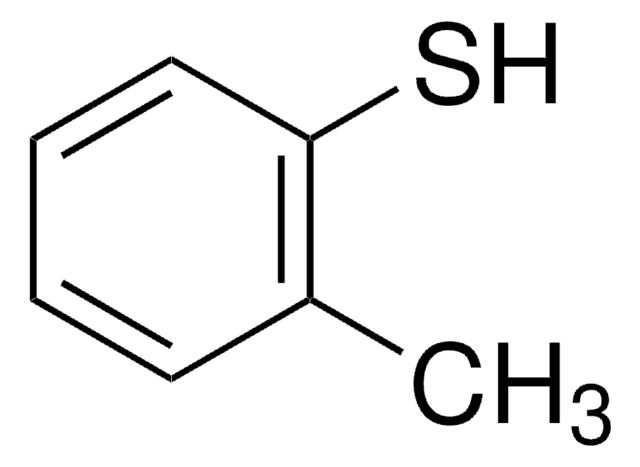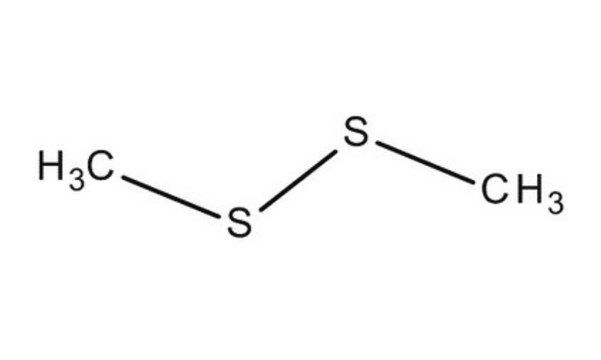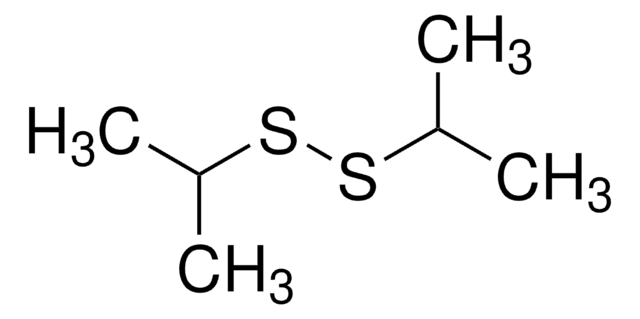おすすめの製品
由来生物
synthetic
品質水準
グレード
FG
Fragrance grade
Halal
Kosher
認証
follows IFRA guidelines
meets purity specifications of JECFA
法規制遵守
EU Regulation 1223/2009
EU Regulation 1334/2008 & 178/2002
FDA 21 CFR 172.515
蒸気密度
3.24 (vs air)
蒸気圧
22 mmHg ( 20 °C)
アッセイ
≥98%
自己発火温度
>572 °F
expl. lim.
16 %
屈折率
n20/D 1.525 (lit.)
bp
109 °C (lit.)
mp
−85 °C (lit.)
密度
1.046 g/mL at 25 °C (lit.)
アプリケーション
flavors and fragrances
文書
see Safety & Documentation for available documents
食物アレルゲン
no known allergens
香料中のアレルゲン
no known allergens
官能
cabbage; onion; vegetable; sulfurous
SMILES記法
CSSC
InChI
1S/C2H6S2/c1-3-4-2/h1-2H3
InChI Key
WQOXQRCZOLPYPM-UHFFFAOYSA-N
類似した製品をお探しですか? 訪問 製品比較ガイド
関連するカテゴリー
アプリケーション
- 異なる方法で乾燥させた Hypsizygus marmoreus の揮発特性解析:ジメチルジスルフィドは、新鮮な魚介類の香りを高めるために使用されることがあり、これは風味を最適化するために使用できることを示しています (Lai et al., 2024)。
シグナルワード
Danger
危険有害性の分類
Acute Tox. 3 Inhalation - Acute Tox. 3 Oral - Aquatic Acute 1 - Aquatic Chronic 1 - Eye Irrit. 2 - Flam. Liq. 2 - Skin Sens. 1 - STOT SE 1 Inhalation - STOT SE 3
ターゲットの組織
Central nervous system, Upper respiratory tract
保管分類コード
3 - Flammable liquids
WGK
WGK 3
引火点(°F)
59.0 °F - closed cup
引火点(℃)
15 °C - closed cup
個人用保護具 (PPE)
Eyeshields, Faceshields, Gloves, type ABEK (EN14387) respirator filter
適用法令
試験研究用途を考慮した関連法令を主に挙げております。化学物質以外については、一部の情報のみ提供しています。 製品を安全かつ合法的に使用することは、使用者の義務です。最新情報により修正される場合があります。WEBの反映には時間を要することがあるため、適宜SDSをご参照ください。
PRTR
第一種指定化学物質
消防法
第4類:引火性液体
第一石油類
危険等級II
非水溶性液体
労働安全衛生法名称等を表示すべき危険物及び有害物
名称等を表示すべき危険物及び有害物
労働安全衛生法名称等を通知すべき危険物及び有害物
名称等を通知すべき危険物及び有害物
Jan Code
W353604-BULK-K:
W353604-5KG-K:4548173338392
W353604-BULK:
W353604-10KG-K:4548173338378
W353604-SAMPLE:
W353604-2KG:
W353604-5KG:
W353604-10KG:
W353604-1KG:
W353604-VAR-K:
W353604-1KG-K:4548173338385
W353604-SAMPLE-K:
この製品を見ている人はこちらもチェック
ライフサイエンス、有機合成、材料科学、クロマトグラフィー、分析など、あらゆる分野の研究に経験のあるメンバーがおります。.
製品に関するお問い合わせはこちら(テクニカルサービス)













